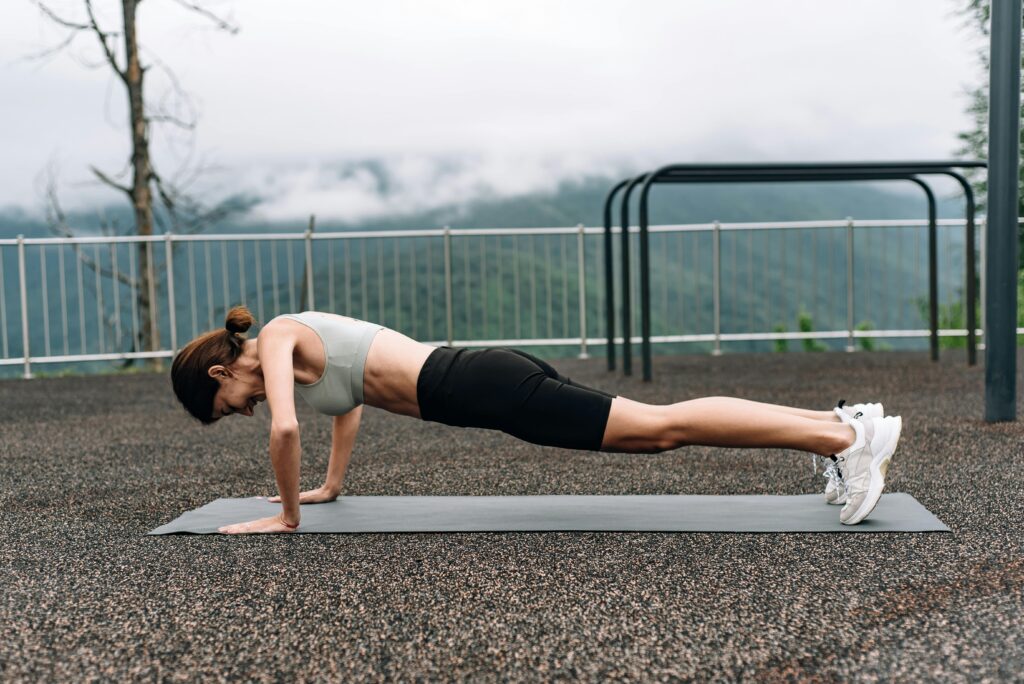Plank exercise are popular recommended by fitness professionals for strengthening your core muscles and more. They’re suitable for people of all ages and fitness levels. The basic plank position is simple: balance on your toes and forearms while keeping your body lifted off the ground. There are also many variations to keep things challenging and fun. Planks might feel intimidating at first, especially if you’re new to fitness. However, they’re incredibly versatile and can be adjusted to suit beginners or made more challenging for advanced workouts.
Regardless of its beginnings, the plank rose to fame about a decade ago, surpassing crunches and sit-ups. Unlike those exercises that can put strain on the spine and hip flexors, planks are gentler on the body while still providing considerable benefits. “The plank exercise targets your postural muscles, shoulders, back of the neck, elbows, triceps, hips, and quads,” It’s a simple yet powerful full-body workout.
Table of Contents
Functional Fitness
Planks are fantastic for boosting functional fitness, a fitness program designed for adults 65 and older.
Doing planks regularly can improve your posture and make daily tasks feel easier. These exercises can be done with body weight or added resistance and are highly adaptable for all fitness levels.
How Can You Start Planking with Ease
If you’re new to planking, at beginning you should do it in a standing position as a gentle way to ease into the exercise. Place your hands on a sturdy surface, like a wall or countertop, and walk your feet back until you’re leaning forward slightly. Keep plank position for 10-15 seconds and repeat it four times.
Holding a plank is a simple yet powerful exercise that strengthens your core, shoulders, glutes, and legs. To perform a plank, begin in a push-up position with your forearms or hands on the ground, keeping your body in a straight line from head to heels. Engage your core, tighten your glutes, and avoid letting your hips sag or rise too high.
Progressing might involve using a lower surface, such as a couch or step, and eventually moving to the floor. For floor planks, you can modify the position by using your knees and hands, or knees and forearms if your wrists need extra support.
Another great starting exercise is the bird dog. Start on your hands and knees, then reach one arm forward while extending the opposite leg backward. This move not only builds core strength but also prepares you for body weight exercises like planks.
No matter which plank variation you choose, maintaining proper form is essential. Focus on activating your core, glutes, and quads to maintain stability throughout your body. Avoid letting your shoulders or hips sag, and keep your back straight no lifting your hips too high or letting them droop. If you’re unsure about your form, consulting a professional like a physical therapist or personal trainer can be helpful.
Breathing is equally important.
Plank exercise Variations to Explore
Once you’re comfortable with floor plank exercise, it’s time to try some fun variations. A variation is the side plank, where you support yourself on one forearm and stack your feet, positioning your body horizontally.
Side Plank
The side plank exercise is great for strengthening your sides, especially your obliques and hips. Lie on your side, lift your hips off the ground while supporting yourself on your forearm, and keep your body in a straight line. Engage your core and hold the position. You can make it easier by bending your bottom knee or harder by adding leg lifts. Regular side planks help improve balance, stability, and core strength. Regular practice of side planks can boost overall functional strength, making daily activities and other exercises easier to perform.
Mountain Climber
To do mountain climbers, begin in a push-up position and alternate bringing your right knee to your right elbow, followed by your left knee to your left elbow, mimicking a marching motion. For a greater challenge, try cross-body mountain climbers by bringing your right knee to your left elbow and your left knee to your right elbow.
Climbing Plank
Begin on your forearms with your toes on the ground, then “climb” up to your hands. To do a climbing plank exercise, start in a forearm plank position, then push up onto your hands one at a time, alternating between moving down to your forearms and back up to your hands. The most important tip is to start slow and ease into planking.
‘’Incorporating plank exercise into your routine can transform your core strength, improve posture, and boost overall stability, helping you feel stronger in both your workouts and daily life.’’
plank exercise benefits
Plank exercises offer several benefits, including:
Core Strength: Planks engage and strengthen the muscles in your core, including your abs, back, and obliques.
Improved Posture: By strengthening your core, planks help improve your posture and alignment.
Enhanced Stability and Balance: Holding a plank requires balance and stability, which improves overall body control.
Supports Other Exercises: A strong core supports better performance in other physical activities and exercises.
Increased Endurance: Regular plank practice builds endurance, allowing you to hold the position longer over time.
Full-Body Activation: Planks engage multiple muscle groups, including the arms, shoulders, glutes, and legs, making it a full-body workout.
Reduces Risk of Injury: By strengthening your core and improving stability, planks help protect your spine and reduce the risk of injury during other activities.

